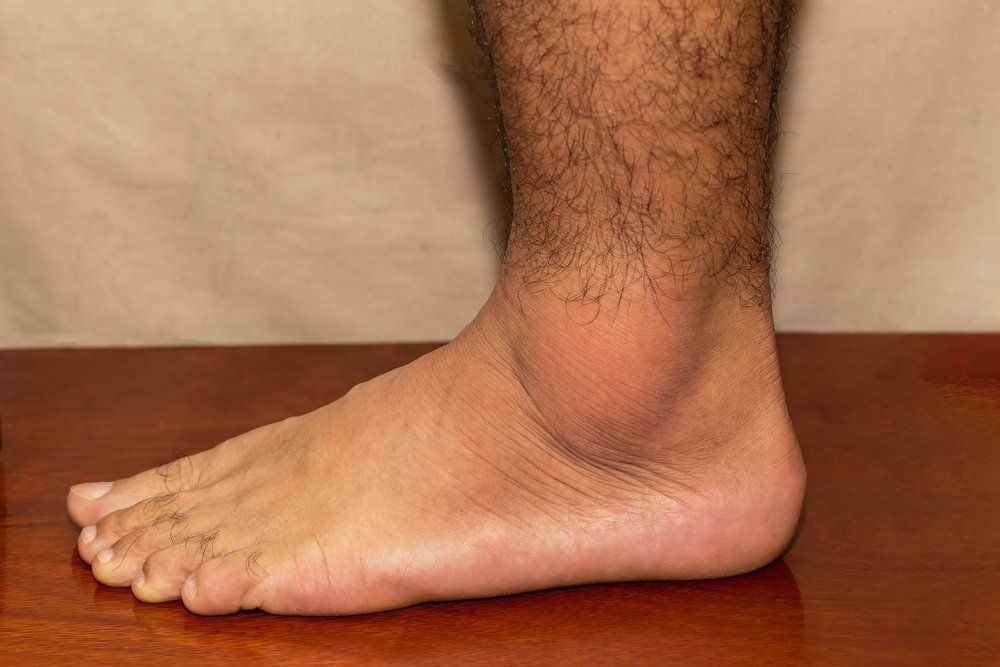Article
Early-Onset Gout May be Associated with Increased Cardiovascular Disease
Patients diagnosed with gout at age 40 or younger may be at increased risk for cardiovascular disease and recurrent gout compared to those diagnosed later in life, according to a new study published in ACR Open Rheumatology.
(Painful gout inflammation on ankle joint. ©ShutterRyderShutterstock.com)

Patients diagnosed with gout at age 40 or younger may be at increased risk for cardiovascular disease and recurrent gout compared to those diagnosed later in life, according to a new study published in ACR Open Rheumatology.
Of 427 adults patients diagnosed with gout at a New England multispecialty group practice, 327 who were aged 40 years or younger at diagnosis were more likely to have cardiovascular risk factors and were less likely to achieve a serum uric acid level below 6.0 mg/dL compared to 100 gout patients diagnosed past age 40 years.
“Clinicians should be aware that patients with early-onset gout may be an undertreated population with poor adherence to [urate-lowering therapy] and increased risk for recurrent gout and cardiovascular diseases,” wrote the authors who were led by Robert Yood, M.D. of Reliant Medical Group in Massachusetts.
A common inflammatory arthritis in adults, gout primarily affects men over 45 years of age. But, along with a doubling in gout prevalence between the 1960s and the 1990s to about 3.9 percent of U.S. adults in 2007-2008, the age at diagnosis appears to be dropping. In 2007-2008, the prevalence of gout was 1.3 percent among those aged 30-39 years and 0.4 percent of those between 20-29 years.
“Along with obesity and hyperuricemia, lifestyle changes in recent decades, including sedentary habits, a diet rich in red meat and fructose, and increased alcohol consumption could play a role in the shift toward a younger population with gout and warrant early intervention,” the investigators wrote.
Previous studies have also suggested that younger-onset gout patients more often have polyarticular flares, higher serum uric acid levels, obesity, and a positive family history for gout. But, overall there’s far less data for those diagnosed earlier versus later in life.
“Given the potential aggressiveness of gout progression and the clinical consequences that would warrant early recognition and intervention, we conducted this retrospective study to investigate the clinical characteristics and treatment of young patients with gout,” the investigators wrote.
They compared 87 patients with a first diagnosis of gout at age 30 years or younger (group 1) and 140 patients initially diagnosed at age 31-40 years (group 2) to a randomly selected group of 100 patients diagnosed after age 40 years (group 3). Groups 1 and 2 were more likely than group 3 to be male (99% and 97%, respectively versus 71 percent, significant at P < 0.001 for groups one vs. three). Body-mass index was also higher (34.6, 33.6, and 31.5kg/m2, respectively, P = 0.007 for groups one vs. three). Obesity was also higher in group one, but not significantly so compared to either two or three.
Those in group 1 were significantly more likely than individuals in either groups two or three to have a family history of gout (30 percent vs. 14 percent and 11 percent, respectively, with P=0.006 and P=0.002, respectively).
Patients in group one had significantly higher uric acid levels at diagnosis (9.2mg/dl) compared with group two (8.4mg/dl, p=0.001) and group three (8.4 mg/dl, p=0.002).
As expected, coronary artery disease, hypertension, hyperlipidemia, and diabetes were all significantly higher among those older than 40 years. But, those characteristics were also found in substantial numbers of the younger groups. Hypertension was found in 41 percent of both groups 1 and 2, and hyperlipidemia in 48 percent and 46 percent, respectively.
By contrast, hypertension has been reported in just 2.2% of the general U.S. population aged 20-29 years and 6.5 percent in those aged 30-39 and hyperlipidemia in 0.4 percent and 2.3 percent, respectively.
The proportions meeting the American College of Rheumatology guidelines for urate-lowering therapy were 74 percent of group one, 48 percent of group two, and 78 percen of group three. For groups one and two, most met the criteria based on the number of gout attacks, while group three individuals were more likely to meet the chronic kidney disease criterion.
A higher percentage of patients in group 1 initially received recommended urate-lowering therapy, whereas only 68 percent of patients in group 3 who met guidelines for urate-lowering therapy initiated treatment. Compared to groups 1 and 2, those in group 3 were more likely to achieve an sUA below 6.0mg/dL (32 percent and 39 percent respectively, versus 53 percent).
Previous studies have found that adherence to urate-lowering therapy for gout is low compared to treatments of other chronic diseases such as hypertension and diabetes, possibly due in part to a lack of counseling about the risk of gout flares with urate-lowering therapy initiation. And, the investigators said, patients with early-onset gout appear to be at particularly high risk for poor adherence.
REFERENCE
Yan Li, Paramarajan Piranavan, Devi Sundaresan, and Robert Yood. "Clinical Characteristics of Early-Onset Gout in Outpatient Setting." ACR Open Rheumatology. Aug. 6, 2019. DOI 10.1002/acr2.11057




